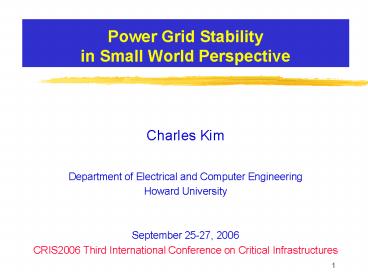Power Grid Stability in Small World Perspective PowerPoint PPT Presentation
1 / 15
Title: Power Grid Stability in Small World Perspective
1
Power Grid Stability in Small World Perspective
- Charles Kim
- Department of Electrical and Computer Engineering
- Howard University
- September 25-27, 2006
- CRIS2006 Third International Conference on
Critical Infrastructures
2
Power Grid and Dynamic Analysis
- Complex Network
- Long Distance Transmission
- Interconnection
- System Stability by State Equation (First order
Differential equation) and Eigenvalue Analysis
Matrix A - Stable
- Unstable
- Planning Tool used as operational tool
3
Causes and Problems
- Major Blackouts
- WSCC 1996, Northeast 2003
- Common Causes
- Equipment Failure
- Vegetation Problem
- Human Error
- But No Single Cause
- Problems (according to report)
- No specific cause singled out
- Assumption and conditions in the dynamic analysis
- Relationships between network topology and system
dynamics recognized but not realized
4
Another Angle Complementary Tool
- Topological analysis of power grid
- Investigation of relatedness with topology and
cascading failure - Random (or intentional) removal of nodes
(generators, substation, etc) or transmission
lines. - Removal of the lines faulted in the actual
failure in the order of event - Topological Changes
- Providing an alternative operational (warning)
tool for system operators - Graphical Perspective of Blackouts and Major
outages
5
Graph Theory
- Number of nodes (n)
- Size Number of edges (M)
- Degree (k)
- Critical Path Length (L)
- Shortest path distance between two nodes
- Clustering Coefficient (g)
- The degree to which neighboring nodes are
connected to each other - 3 types of network
- Regular
- Random
- Small World
6
Small World Network
- A small world graph is any graph with a
relatively small L and a relatively large g. - Small World Criteria
- L is close to Lrandom ln(n) / ln(k)
- g is much greater than grandom k / n
- Characteristics that make the small world
phenomenon interesting - The network is large
- The network is sparse people (or things) are
connected to a small fraction of the total
network - The network is decentralized -- no single (or
small ) of stars - The network is highly clustered -- most
friendship circles are overlapping - globally significant changes can result from
locally insignificant network change
7
Small World and Dynamics
- Topology affects dynamics
- Small world topology enhances signal propagation
- The dynamics are very non-linear -- with no clear
pattern based on local connectivity. - Diseases move more slowly in highly clustered
graphs - small local changes (shortcuts) can have dramatic
global outcomes (disease diffusion) - Infection of a whole population (an example)
- Regular Graph5 steps
- Random Graph3 steps
- Small World3 steps
8
Power Grid small world? - 14bus
9
Graph Analysis of Power Grids
- Larger networks are small world networks
10
Is it relevant?
- Some Recent Findings Suggestions
- The density of shortcut edges is an important
factor in determining the probability of
large-size epidemics, or failures. - Networks with a very high density of shortcut
edges exhibit primarily large-size failures. - Networks with no shortcut edges tend to have only
small-size failures. - Thus, the presence of a few shortcut edges
greatly increases the probability of large-size
failures. - Removing tie lines from power systems is
obviously impractical, but monitoring and
protection strategies could be employed to reduce
the chance of disturbance propagation and
cascading failures. - Other Related Articles
- Model for Cascading Failures in Complex
Networks PHYSICAL REVIEW E 69, 045104(R), (2004)
- Dynamics of Small World Networks and
Vulnerability of the Electric Power Grid, 8th
Symposium of Specialist in Electric Operational
and Expansion Planning), Brazil, May 2002 - Cascade Control and Defense in Complex Networks
Phys. Rev. Lett. 93, 098701(2004) - Network Models Growth, Dynamics, and Failure
Proceedings of the 34th Hawaii International
Conference on System Sciences-2001 - Cascading Failure Analysis of Bulk Power System
Using Small World Network Model 8th
International Conference on Probabilistic Methods
Applied to Power Systems, Iowa State University,
Ames, Iowa, September, 2004
11
WSPP Cascading Failures in 1996
12
Reconstruction of WSCC Faults
13
L and g Comparison Scenarios
14
Graphical Property Changes in the Scenarios
g
- the critical path lengths for the July outage
scenarios show much higher than those of other
scenarios including the no-outage scenario. - a little increase in the path of the two August
outage scenarios.
15
Conclusions and Remarks
- the preliminary results shown in this section do
not directly answer the hypothesis of topological
changes vs. cascading failures. - The comparison of the scenarios is not complete.
The sequential event (or line removal) and its
effect to the critical path length and the
clustering coefficient were not performed. - Furthermore, the preliminary study was performed
on reduced size grid of the WSCC grid. - However, the preliminary results shed some
insight in that they could relate the cascading
outages to static topological measures, along
with the dynamic indices that were traditionally
used in a power operation modeling. - further investigation is in need for the possible
correlation of the topological measures to
cascading outages. - The basic method for this feasibility study is to
graphically analyze all North American power
grids that experienced major outages for a
possible representation of a grid in terms of
topology for its operational and stability
status.

